Posted in category "Scandals"
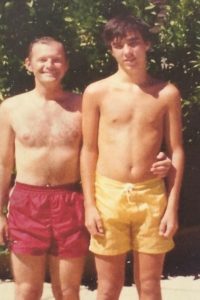
The Report on the Holy See’s Institutional Knowledge and Decision-Making Related to Former Cardinal Theodore Edgar McCarrick (1930-2017) was issued by the Vatican’s Secretariat of State on November 10, 2020. The report was authored by U.S. attorney, Jeffrey Lena, who had previously represented the Vatican in several sex abuse cases. The 449-page document is the result of a two-year investigation, prompted by the public demand by Archbishop Carlo Vigano that Pope Francis resign for his alleged leniency to Cardinal McCarrick. Archbishop Vigano’s “testimony” was released on August 25, 2018 and splashed all over ultra-conservative Catholic media outlets. Gossipy and salacious, he pointed the finger at Pope Francis as the chief villain. Since then, the Vatican had been under heavy pressure to provide an explanation for Cardinal McCarrick’s rise, and his continued influence within the Church after rumors and accusations of sexual activity circulated for several decades.
Before his downfall, Cardinal McCarrick was a star among the U.S. Catholic hierarchy, both for his fund-raising prowess and his sophistication about American and global affairs. He brought the Vatican millions of dollars from the U.S. for papal charities.
Who are the main villains in The McCarrick Report?
#1 – Cardinal Theodore McCarrick. A man who used his position, influence, and financial gifts to manipulate or coerce seminarians and altar servers to have sex with him; and protect him from any career consequences. Many of his victims were children of family friends. All of the seminarians depended on his patronage to be ordained.
#2 – Pope John Paul II (1979-2005) – Pope John Paul II turned a blind eye to clerical sexual activity. His main concerns were freeing Poland from communism, keeping communism out of Latin American, and stamping out North American and European reformers and dissenters. His courtiers had free rein, especially after the mid-1990s when he began to suffer from Parkinson’s Disease, and became increasingly incapacitated mentally and physically. His hubris and handlers kept him propped up in Peter’s Throne so the good times could continue to roll. He ignored numerous complains about McCarrick, and continued to promote him from Bishop of Metuchen, NJ (1981), to Archbishop of Newark, NJ (1986), Archbishop of Washington, DC (2000), and finally named McCarrick a cardinal (2001). The best article I ever read about Pope John Paul II’s culpability in the Church’s sex abuse holocaust is Maureen Dowd’s A Saint, He Ain’t. Poland’s bishops lobbied hard for John Paul II’s early beatification and canonization but were rebuffed in 2019 when they petitioned the Vatican and fellow prelates worldwide to have him elevated still further as a Doctor of the Church and patron saint of Europe.
#3 – Cardinal Stanislaw Dziwisz. The McCarrick Report contains 45 references to Dziwisz, who first met McCarrick while visiting New York with the then, Cardinal Karol Wojtyla in 1976. When Karol Wojtyla became Pope John Paul II in 1978, Dziwisz served as his personal secretary for the Polish pontiff’s entire 27-year reign. Cardinal Dziwisz is accused of covering up sexual abuse in exchange for money. One of McCarrick’s victims, James Grein, said he once accompanied McCarrick on a trip to the Vatican with a briefcase containing envelopes full of money. The envelope addressed to Dziwisz held $10,000. 
The role of the former papal secretary in stifling sex abuse claims and protecting clerical abusers as favors or for money has come under recent scrutiny in Poland. A 90-minute documentary, “Don Stanislao” was recently shown on TVN24 in Poland. The film aired a long list of accusations about Dziwisz, from covering up for his friends in the seminary to the his role in protecting the late Father Marcial Maciel, the disgraced founder of the Legionaries of Christ, and former Cardinal McCarrick. The documentary also detailed how as archbishop of Krakow he ignored complaints against subsequently convicted local priests.
#4 – Pope Emeritus Benedict XVI – Pope Benedict asked Cardinal McCarrick to step down as archbishop of Washington, DC in 2006. Since he was 76, a year past the age of retirement, the request wasn’t extraordinary. “Over the next two years, Holy See officials wrestled with how to address issues regarding Cardinal McCarrick,” the report’s summary states. “Ultimately, the path of a canonical process to resolve factual issues and possibly prescribe canonical penalties was not taken,” the summary concludes. “Instead, the decision was made to appeal to McCarrick’s conscience and ecclesial spirit by indicating to him that he should maintain a lower profile and minimize travel for the good of the Church.” That didn’t happen; McCarrick continued his global lifestyle and high visibility.
Pope Benedict did and said nothing. Benedict also gave himself the excuse that McCarrick was already retired in not initiating formal disciplinary proceedings. “God’s Rottweiler” as the head of the Congregation for the Doctrine of the Faith (1981-2005) silenced and censored numerous theologians, bishops, priests and religious during his tenure. He decried secularization, liberation theology, feminism, homosexuality, religious pluralism, and bioethics. He gave clerical sex abuse and rape a pass.
#5 – Four New Jersey Bishops. These men vetted Archbishop of Newark McCarrick for the prestigious Washington, DC appointment—Bishop Emeritus Edward Hughes, Metuchen; Bishop John M. Smith, Trenton; Bishop James McHugh, Camden; and Bishop Vincent DePaul Breen, Metuchen. Of the four, only Bishop Edward Hughes advised that it would be “unwise to consider the Archbishop for any promotion or additional honor.” Even so, Bishop Hughes did not pass on reports from seminarians and priests who told him they had been abused by McCarrick. Both James McHugh of Camden and John Smith of Trenton witnessed McCarrick groping a seminarian at a dinner party but never reported it. 
All the New Jersey bishops confirmed the rumor that McCarrick persuaded seminarians to share his bed at his New Jersey Shore house. The Vatican report does not explain by these bishops would not regard sleeping with young men—at minimum–as a serious impropriety and lack of judgement. Nor does it indicate why it didn’t raise a red flag for sexual activity for Vatican officials. The report also included an allegation by an unnamed Metuchen priest who accused McCarrick of having sex with a third priest in June 1987. The accuser was not originally believed since he “had previously abused two teenage boys.”
As expected, The McCarrick Report has plenty of dirt to throw on the legacy of Pope Saint John Paul II: he didn’t bother to investigate sex crimes. That way, he never had sufficient evidence requiring him to act. Because he chose to look the other way, thousands of children, teenagers, seminarians, and vulnerable adults were victimized by clerical predators. The failure of his moral leadership deeply wounded the Catholic Church and many people of faith.
The Report highlights repeated failures in the processing of vetting bishops, a process that often seems more focused on personal connections and ensuring unquestioned adherence to doctrine rather than raising red flags on inappropriate or criminal behavior.
The system in place where archbishops are expected to police abuse by bishops is totally inadequate.
Finally, it shows how certain Vatican prelates—Cardinal Dziwisz and Cardinal Sodano chief among them—were happy to let crime and sin slide if they were paid.
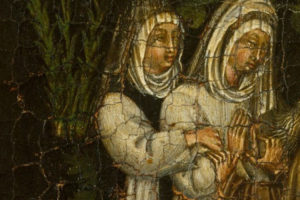
Benedetta Carlini (1590-1661) was a mystic, seductress and nun. Dr. Judith C. Brown chronicled her life in the 1986 book, Immodest Acts. The book came on the heels of Rosemary Curb and Nancy Manahan’s bestseller, Lesbian Nuns: Breaking Silence, which was published in 1985. Benedetta was Abbess of the Convent of the Mother of God in Pescia, Italy when she was accused of heresy and “female sodomy.” Her story is important not only as a documented lesbian relationship in the convent, but how an intelligent, persuasive woman gained, experienced and exercised power and celebrity within Catholicism’ male-dominated structure. In the end, she was brought low by jealousy and her own excesses. She also had miscalculated the tectonic shift in the Church from the Counter Reformation: principally an emphasis on correction of clerical abuses, and more emphasis on intellectual understanding vs. supernatural manifestations of divine favor.
The story of Abbess Benedetta Carlini was discovered by accident by Dr. Brown, a historian at Stanford University while she was researching the economic history of the region and the Medici rule. “I found Benedetta Carlini by chance, by leafing through an inventory of nearly forgotten documents in the State Archive of Florence. The entry in the inventory read: ‘Papers relating to a trial against Sister Benedetta Carlini of Vellano, abbess of the Theatine nuns of Pescia, who pretended to be a mystic, but who was discovered to be a woman of ill repute.’” This discovery of an ecclesiastical investigation contained what is probably the earliest account of a sexual relationship between two nuns. The documents concerning Abbess Benedetta Carlini consisted mostly of transcripts of a series of inquests between 1619 and 1623. 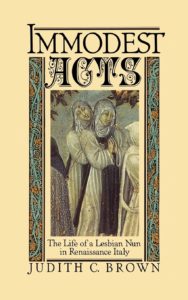
In 1986, Dr. Brown published her book about Benedetta’s life, investigations, and trials. Titled Immodest Acts: The Life of a Lesbian Nun in Renaissance Italy. It was widely reviewed in both scholarly and popular journals and publications. I talked to Dr. Brown about speaking at the Conference for Catholic Lesbians (CCL) West Coast conference in May 1986. Unfortunately, she wasn’t available to participate. Too bad, because many scholars are dry and pedantic, and I found Dr. Brown to be both engaging and knowledgeable. She was one of a handful of women at that time to write an even-handed account of lesbianism who was not a lesbian herself. The book served as a prop in Su Friedrich’s sensational 1987 film, Damned If You Don’t.
Benedetta’s parents brought her to the convent in 1599 when she was nine years old. She entered the Sisters of the Immaculate Conception of the Virgin Mary, more commonly known as the Theatines. The order was founded in 1583 by the Venerable Ursula Benincasa, who was famous for her visions and piety. The fame she gained from her visions led some to accuse her of being possessed by a devil. In 1617, Ursula had her most famous vision, where Jesus (in some versions, Mary) appeared to her. In the vision Jesus praised her order and promised them salvation. Ursula died in 1618 at the age of 71. Benedetta grew up learning about Ursula’s visions and the fame and power that proceeded from them. 
Like the Venerable Ursula, Benedetta had visions. In 1613, when she was 23, she reported visions to the mother superior and her confessor. A young boy helped her climb the “Mountain of Perfection;” she was surrounded by wild animals, only to be saved by Jesus. In another vision, while praying one morning, she found herself “in a garden, surrounded by fruits and flowers.” Male figures came to dominate her visions—a beautiful youth, young men who beat her with sticks, chains, and swords; a handsome guardian angel named Splenditello, and Jesus himself. Over time, the visions increased in intensity and detail, and Benedetta became well known for them. Fearful that Sister Benedetta was being harassed by demonic forces, Sister Bartolomea Crivelli was assigned to share her cell, observe her, and help her if possible.
On the second Friday of Lent 1619, Benedetta received an unmistakable sign of divine favor, the stigmata. Prior to this event Benedetta and others in her community were unsure if her visions were divine or diabolical in origin; but by manifesting the wounds of Christ she proved their divinity.
Her celebrity as a mystic blossomed. That same year the Theatine nuns elected her as their abbess.
Shortly after her election, she began to deliver sermons to the other nuns. She spoke in a trance, an angel speaking through her, exhorting the nuns to purify themselves, and be grateful for Benedetta’s presence in their midst. In the months that followed, there were more trances and visitations: from St. Catherine of Siena and an angel—a beautiful youth in a white robe named Splenditello, even Jesus himself. They spoke from within Benedetta, at times with loving praise, other times harshly or issuing commandments, such as a ban on eating meat, eggs, and dairy products.
On May 20, 1619, Jesus appeared to Benedetta and told her he wanted to marry her in a special ceremony. He had specific ideas for the procession, the chapel decorations, list of guests and the ceremony itself. At the wedding, while the other nuns watched and listened, Benedetta claimed the Blessed Mother looked on benevolently while Jesus placed a gold ring on her finger. Speaking through her, Jesus said, “I would like that this, my bride, be empress of all the nuns.” He added that the Great Duke of Tuscany should be informed of her greatness. All those who did not obey, believe, and cherish her would be punished.
Although the nuns had gone along with Benedetta’s visions, the self-flagellation during trance-sermons and even a ban on salami and cheese; the wedding with Jesus and his dictate that they should obey her or face divine punishment was a step too far. They reported her to the ecclesiastical authorities, who investigated her twice between 1619 and 1623. They discovered that she had faked the stigmata by pricking herself with a needle; secretly ate salami and mortadella during her “ban” on meat and dairy and painted on her miraculous wedding ring with saffron.
But the most damning, was the confession of Sr. Bartolomea Crivelli, Benedetta’s assigned companion. She described her two-year affair with the abbess. The women met for sex at least three times a week. “Embracing her, she would put her under herself and kissing her as if she were a man, she would speak words of love to her. And she would stir so much on top of her that both of them corrupted themselves.” They also masturbated each other and had oral sex to orgasm. Mutual fondling carried a relatively light penalty—two years of penance, plus the loss of Benedetta’s status as abbess. The fact that Benedetta claimed “Splenditello” the angel committed the sexual acts allowed clerical investigators to classify all of Benedetta’s supernatural visions as diabolic in nature. In their report, investigators criticized Benedetta’s “immodest and lascivious language,” and “the great display of vanity” of her mystical marriage with Jesus. 
Benedetta, 36, was condemned to involuntary hermitage and spent the remaining 35 years of her life in solitary confinement. The only other mention of Benedetta is an August 1661 entry in an unnamed nun’s diary stating that Benedetta Carlini died at age 71 of fever and colic pains. The nun added that Benedetta was “always popular among the laity.” For her confession, Sr. Bartolomea Crivelli was spared any punishment. She died in 1660, a year before Benedetta.
Why the long solitary confinement? I suspect jealousy, anger at her duplicity, and fear that her charm and intelligence could help her reclaim a leadership position led some nuns to promote her isolation within the community. She would feel her losses every day. Church authorities wanted to discourage her dangerous popularity with the laity. Her supernatural claims were unwanted in the new age of science and Counter-Reformation.
There is no record of what Benedetta thought and felt after she was led to her lonely cell. Did she have any regrets? Did she revisit her visions– real, imagined or devised? Did her thoughts ever stray to Bartolomea, lying in her bed nearby?
Benedetta Carlini has been the inspiration or subject of films, plays and articles. They include:
Immodest Acts: The Life of a Lesbian Nun in Renaissance Italy by Judith Brown, Oxford University Press, 1986
Damned If You Don’t – a film by Su Friedrich in 1989. If you want to see the film, below are the links for streaming and for DVD

Damned If You Don’t
Vimeo streaming for $3.99
DVD for $24.99
Discourses of Desire: Sexuality and Christian Women’s Visionary Narratives,” by E. Ann Matter, Journal of Homosexuality, 1989-1990
Big Gay Portal to Hell, a podcast by Catherine Clune-Taylor on Caveat
Stigmata, a 2011 play by Carolyn Gage
Vile Affections: Based on the True Story of Benedetta Carlini, a 2006 play by Vanda
Benedetta Carlini: Lesbian Nun of Renaissance Italy, a play by director and playwright, Rosemary Rowe.
Benedetta, an upcoming film directed by Paul Verhoeven and starring Virginia Efira as Benedetta. The film is scheduled to premiere at the 2021 Cannes Film Festival.
I always enjoy the Cross Sound Ferry ride from Orient, NY to New London, CT. I look out over the water and imagine what lies beneath. Somewhere underneath the rolling waves are four centuries of shipwrecks, lost fishing nets and tackle, Coke bottles, busted lobster traps, and the remains of Danny Walsh, encased in cement shoes.
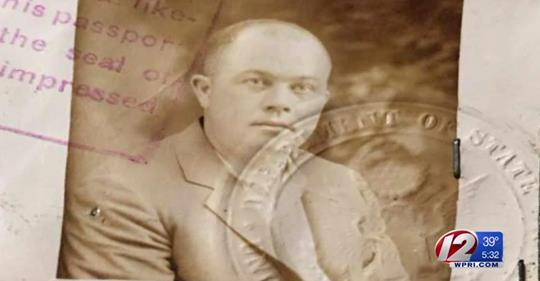
Danny Walsh
Danny Walsh was one of the most successful bootleggers during Prohibition, and the last major Irish-American gangster in Southern New England. He was kidnapped and murdered in 1933. His remains were never found.
A first generation Irish-American, Walsh was born in 1898 in the neighborhood of “Valley Falls” in Cumberland, Rhode Island. He was the son of John and Mary Walsh and was the second of nine children. When Prohibition started Walsh was earning $5 a day working in a Pawtucket, Rhode Island mill. Walsh became one of the most famous rum-runners during the 1920s. He assembled a formidable operation which included planes, automobiles and a fleet of boats. These speedboats were armor plated with layers of New York telephone directories to ward off Coast Guard machine gun fire. The boats would go out to the 12 mile limit, known as “Rum Row” to meet ocean-going vessels. Walsh’s exploits were chronicled in local papers, including the infamous incident of December 1929, when one of his smuggling speedboats, “The Black Duck,” came under fire by a Coast Guard gunship.
Rhode Island was the most Catholic state in the country, and many of the state’s Irish, Italian, French-Canadian and Polish citizens regarded Prohibition as a Protestant plot against their social life. Enforcement was lax.

Charles “King” Solomon
As the Roaring 20s roared along, Walsh prospered and became a protégé of Charles (King) Solomon, Boston’s legendary crime boss. Solomon made Walsh the northeast distributor of high-quality Canadian alcohol. Sam and Harry Bronfman of Seagram Company were happy to sell legal Canadian whiskey at 65 cents a gallon. Walsh could sell the same gallon for $7 in the U.S.
By 1925 Walsh had made a huge fortune as one of the country’s largest bootleggers. Considering himself a “gentleman farmer” Walsh spent a lot of money on thoroughbreds which he raised on his farm in Charlestown, Rhode Island. He became an accomplished horseman. Affable and politically savvy, he kept his political allies and bankers stocked with hard liquor. In 1928 Federal authorities charged him with tax evasion, arguing he owed the government $350,000 in unpaid income taxes. Walsh bargained the figure down and paid. When anyone asked, he told people he was a hobby farmer who had made shrewd investments.
Walsh was rumored to be part of the “Irish Combine,” a group of Irish gangsters heavily involved in bootlegging. They included Big Bill Dwyer and Owney Madden of New York City, Larry Fay on Long Island, NY, Walsh in Providence, RI, Daniel O’Leary of Philadelphia, PA and Joseph Kennedy of Boston, MA. 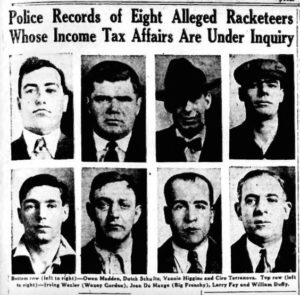
One of the most notorious bootleggers during Prohibition was Carl Rettich, a New Jersey born criminal who got his start at age 17 in the mob-controlled live poultry business. He overheard a plot to murder a wholesale poultry dealer but kept his mouth shut. In September 1924, 30-year-old Rettich was charged with the murder of Frank d’Agostino, a gangster who was known by police as a “hijacker” of bootleg liquor. D’Agostino told friends that he planned to meet with Rettich to discuss returning the whiskey he had stolen from him. Instead he ended up on a pier with four bullets in his neck and chest. Rettich was an associate of George F. (“Doc”) Moeller’s, alleged whisky smuggler, who disappeared a few weeks earlier with $150,000. The police were unable to trace his whereabouts, although they believed he fled to Germany.
Rettich relocated to Rhode Island at Walsh’s invitation. Together they expanded operations. Known to his Warwick Neck, RI neighbors as “Charles Ryerson,” area people believed him to be a respectable attorney who had moved to Rhode Island to care for his aging father. Rettich threw parties for politicians and the local elite, letting people fire his machine gun on the front lawn.
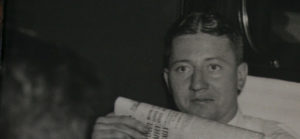
Carl Rettich
On January 23, 1933, Charles “King” Solomon was gunned down in the men’s room at Boston’s Cotton Club. His boss and protector dead, ten days later Danny Walsh disappeared.
Walsh was last seen the night of February 2, 1933 at the Bank Café in Warwick, RI having dinner with Rettich, Rettich’s young associate, nicknamed “Wireless,” and two other unidentified men. A waitress testified that Walsh and Rettich were in good spirits, but a second witness disagreed, claiming the men had an argument over an unpaid debt. Rettich paid Walsh $30,000 to settle it. Danny Walsh disappeared. Local police and a Federal inquiry into his disappearance went nowhere.
The Associated Press ran a story on June 3, 1935 speculating that Walsh “was stood in a tub of cement until it hardened about his feet, and then thrown alive into the sea.” The AP reported it was just a “grisly underworld tale.”
According to unnamed informants, Walsh had been taken to the basement of Rettich’s home and clubbed. He was put in a box that was filled with concrete and dumped in the ocean. Walsh’s girlfriend was given the same treatment for being too vocal about his disappearance. Another rumor had Walsh’s body stuffed in a barrel filled with cement and dumped in the sea off Block Island. No bodies were ever found. Police Captain Alfred Stevens of Providence, RI believed Rettich murdered Walsh to take full control of the business and reclaim his $30,000 payment.
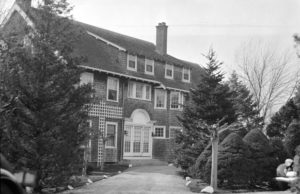
Murder Castle
The Providence Journal received a tip that some “Chicago interests” might have staged Walsh’s kidnapping, upset he was encroaching on their territory in western Massachusetts. The Journal’s front-page story on February 11, 1933 reported that Walsh might have been kidnapped for a $40,000 ransom. A few days after his disappearance, Walsh’s brother, Joseph Walsh, received a ransom note demanding $40,000. Joseph Walsh, Carl Rettich, and two other men traveled to the Copley Plaza Hotel in Boston. There they handed the $40,000 to a man that none of them saw. He collected the money by slipping “his hand through a hotel room door.” Despite promises from the kidnappers, Walsh never resurfaced.
Over the next several years authorities would often investigate unidentified murder victims in hopes of finding Danny Walsh; “any time a suspicious corpse was found—in Massachusetts or Rhode Island woods—or a skull turned up in a fishing net off Block Island, police checked it against Danny Walsh’s dental records.” The bodies of Danny Walsh and his girlfriend were never found. What happened to Danny Walsh? No one knows, but what is left of him is probably at the bottom of Block Island Sound.
Rettich’s luck ran out in 1935. He was convicted on multiple charges for a Fall River, MA mail heist that netted $129,000. He was sentenced to 25 years in prison and spent the rest of his life there. Rettich is footnote now in Prohibition history, but he is the inspiration for the enduring legend of cement shoes. 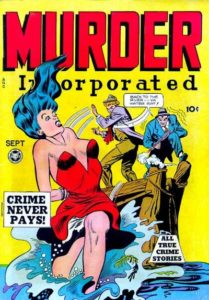
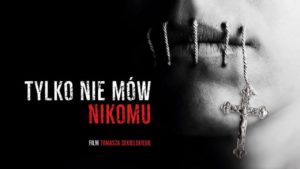
The 2019 Polish documentary on clerical sex abuse, “Tell No One” highlighted a problem: Many of the priestly sex abusers and credibly accused child molesters are well-loved and respected national and local figures. Some people are pushing for a total accounting; others stress individual forgiveness and resumption of public ministry. Notable figures include –
-Father Henryk Janknowski, one of the founders of the Solidarity union. He had his statue removed in Gdansk.
– Father Eugeniusz Makulski, who oversaw the construction of Poland’s biggest basilica. He commissioned a statue of himself offering the building to St. Pope John Paul II. I found his kneeling in front of the pope an apt pose, considering what he is. Makulski’s representations have been removed from the shrine. 
-Father Franciszka Cybula, personal chaplain to anti-Communist hero Lech Walesa. Slawoj Leszek Glodz, Archbishop of Gdansk, lavished praise on Cybula and gave him a grandiose funeral.
– Cardinal Henryk Gulbinowicz, a much-loved figure who helped lead Poland’s anti-Communist movement.
–Archbishop Jozef Wesolowski, former archbishop of Krakow and papal envoy. He was quietly recalled from the Dominican Republic in 2013. Wesolowski was accused of possessing child pornography and paying poor boys and teens for sex acts. Luckily, he died of a “heart attack” before his canonical trial was about to begin. Wesolowski was also wanted on sex abuse charges in Poland. It seemed to me he had quite a good clerical showing at his funeral. 
On August 1, 2019, Archbishop Marek Jedraszewski of Krakow celebrated a Mass commemorating the seventy-fifth anniversary of the outbreak of the 1944 Warsaw Uprising. Archbishop J?draszewski said in his homily: “The red [communist] plague no longer walks on our earth, but a new neo-Marxist one that wants to conquer our souls, hearts, and minds has appeared. It is not a red, but a rainbow plague.”
Did he mean Poland’s pedophile and sex abuser priests, bishops and cardinals; or, was he referring only to Polish LGBT activists?

I received this mailer from Catholic Vote. I’m sure they got my name from my subscription to the National Catholic Register. I am a pro-life voter–not just a pro-birth voter. Catholic Vote started out as a Pope Benedict fan club. They have now evolved into some kind of conservative Catholic PAC.
When presented with such a stark choice for candidates it’s very easy to pick: NANCY PELOSI, and the fundamental Catholic values and upbringing she represents.
How on earth, as a faithful Catholic, could I vote for what Donald Trump, Ronald Reagan and John Paul II represent:
Donald Trump – A coarse, nasty, misogynist, pathological liar.
Ronald Reagan – The man who destroyed the American working class by opening the floodgates to globalization and corporate maximization of profits vs. giving people at home a decent living wage.
Pope John Paul II – Ignored or protected priestly predators and their enablers while thousands of innocent children, teens and seminarians were raped and sexually abused. Under his watch the Vatican bank was a den of thieves washing dirty money and funding luxurious lifestyles for corrupt prelates. And don’t forget–he never met a military dictatorship he didn’t prefer over poor peasants and indigenous peoples.
Catholic Vote needs to rethink their presentation materials.
In 1985 the book, Lesbian Nuns: Breaking Silence, was published by Naiad Press. It was an explosive best-seller, thanks to the Boston Archdiocese and Cardinal Bernard Law, who complained about a local television interview with the book’s two editors. The archdiocese described the program as “an affront to the sensitivity of Roman Catholics.” The station cancelled the segment, and sales soared. “This is crazy,” Barbara Grier, a founder of Naiad Press told The New York Times, scrambling to fill orders for the book, “I’m a mouse giving birth to an elephant.” The editors, Rosemary Curb and Nancy Manahan, did have a successful appearance on the Phil Donohue show in April 1985 and went on a national tour for the book. Naiad Press went through four printings of the book, and eventually sold the mass distribution and paperback rights to Warner Books in 1986. Lesbian Nuns eventually sold several hundred thousand copies. 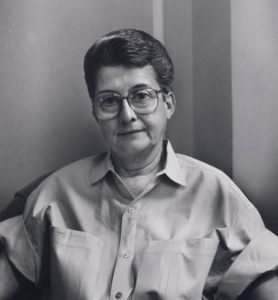
Lesbian Nuns: Breaking Silence included stories by 42 former nuns and women religious, and nine women still in religious life. Most used pseudonyms. All of them wrote about either discovering or acting on their lesbian identity while still in religious life. While there were very few detailed descriptions of sex and seduction, Naiad’s marketing promised to reveal what really goes on behind convent doors, breaking the silence “about erotic love between women in religious life.” While the lesbian religious in the book had affairs or relationships with other sisters, they also fell in love or lust with lay women, married and single. Often the love affair or sexual relationship was the cause of them leaving the convent: it was too hard to maintain a lover relationship and live a religious life. Sometimes the relationships continued but often they did not. I met and knew several of the contributors:
Nancy Manahan, one of the co-editors, worked with the Conference for Catholic Lesbians (CCL) to solicit contributors to the book. She also did a workshop on the book at our 1986 conference. I found Nancy to be a lovely, gracious, caring person.
Susan Weaver was an elegant, elderly woman. We got together several times during my visits to my parents home in Vermont. She made me a beautiful Christmas ornament that I put on my tree every year in memory of her.
Pat O’Donnell was a Dominican sister working at Picture Rocks Retreat house in Tucson, Arizona. She lost her job as the result of her coming out in the book. Pat continued to live and work in Tucson doing spiritual direction.
“Kate Quigley” lived in Montreal and had a long-term relationship with a married woman. The woman’s husband was aware of it. The three of them would go away on vacation together.
Charlotte Doclar worked with Sr. Jeannine Gramick at New Ways Ministry to outreach to lesbian nuns. I met her at a retreat for Catholic lesbians in 1981. Charlotte was friendly, jocular and good-natured. Her story is on the LGBTQ Religious Archives Network.
Dianne Weyers entered her community when she was 14. She left when she was in her late 30s or early 40s with a mysterious back ailment no doctor was able to diagnose but had a crippling effect on her. Since she could not sit upright for long, I typed her manuscript for the book. She felt very unwanted and persecuted by her community, particularly one sadistic superior. I never quite knew what to make of her.
“Sister Maria Nuscera” was a very vivacious lesbian religious in the Midwest. She fell in love and had an affair with a parishioner.
Margaret “Peg” Cruikshank was not one of the lesbian nuns but was one of the driving forces behind the creation of the book. Rosemary Curb and Nancy Manahan, the book’s co-editors, had previously published their own stories as lesbian religious in The Lesbian Path. Peg edited that book and introduced the pair in June 1981. She suggested to Barbara Grier that Manahan and Curb edit a book about lesbian nuns.
The nun on the cover of the book with the “come hither” look was Jean O’Leary, who left the convent and went on to become a co-director of the National Gay and Lesbian Task Force. 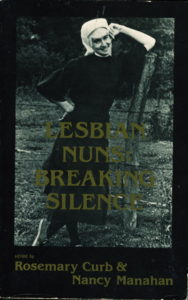
The Conference for Catholic Lesbians (CCL), was a group founded in the early 1980s to promote Catholic lesbian visibility and community. Beginning in 1982, the group had advertised and promoted the Lesbian Nuns book project to its members and readers, many of whom were lesbian religious and ex-nuns. CCL’s newsletter editor at that time, a wonderful woman named Pat, knew of Barbara Grier through the Daughters of Bilitis. DOB or Daughters was the first lesbian rights organization in the United States. Pat had been one of the editors of its newsletter, The Ladder. She described Grier as an aggressive, single-minded butch.
The unthinkable happened shortly after the publication of Lesbian Nuns. Barbara Grier, working to maximize income and visibility, offered excerpts of the book to gay and women’s publications like Philadelphia Gay News and Ms. Magazine. She also offered excerpts to Forum magazine; a men’s soft-core porn magazine published by Penthouse. The lead headline in the June 1985 Forum blared in capital letters: SEX LIVES OF LESBIAN NUNS. The lesbian nun stories that Forum bought included “They Shall Not Touch, Even in Jest,” “Finding My Way” and “South American Lawyer in the Cloister.”
Grier justified the decision by stating it would help the book reach a wider audience. She claimed that many women, some of them closeted lesbians, read their male family members’ copies of the magazine. An estimated 15% of Forum readers were female. In an interview with WomaNews, she expressed surprise about the outrage her Forum sale generated— “I had no idea anyone would object.” Even if you are a huge Barbara Grier fan, these two assumptions are hard to accept.
Since CCL had helped to solicit contributors to the book, personally, and through our conferences and newsletter, the organization sent a letter to Barbara Grier protesting the sale of the stories to Forum. We did get a letter back from her a few weeks later. The letter is now lost, but I remember what she wrote. The tone was matter of fact, no apology. She sold the rights to Forum to try to reach as many lesbians as possible. I don’t know if the tiny sliver of lesbian Forum readers would even be interested in the book, but the ensuing controversy certainly helped sales and attracted new customers to Naiad Press. Lesbian Nuns was their greatest publicity tool and best-selling book ever.
Naiad Press was founded in 1973 by Barbara Grier, her partner, Donna McBride, and another couple, Anyda Marchant and Muriel Crawford. The business began with $2,000 provided by Marchant, their first author. She wrote under the pen name, Sarah Aldridge. Over the years Naiad published over 500 books on unconditionally lesbian themes. Mostly romance novels, they included erotica, mysteries and science fiction. Naiad also reprinted some of the most important lesbian pulp novels of the 1940s and ‘50s, including the Beebo Brinker Chronicles by Ann Bannon. Their authors included Jane Rule, Katherine V. Forrest, Claire McNab, Lee Lynch and Karin Kallmaker. Cartoonist Alison Bechdel used to lampoon Naiad books by giving them bar code covers. Grier told Bechdel when she met her that she always loved seeing Naiad jokes in her comic strip. The founders fiercely disagreed over the Forum sale and it precipitated a split a few years later. 
In 1973, no bookstores would take lesbian themed books, so Naiad started as a mail order business. Its initial list of 3800 names was the Daughters of Bilitis (DOB), membership list that Grier purloined when the organization folded in 1970. Grier used it to keep publishing The Ladder, DOB’s newsletter, for another two years until funding ran out. Many DOB activists felt Grier stole the list, but she defended her action as necessary for the magazine’s continued existence: “DOB was falling apart—we wanted The Ladder to survive.”
Grier got her start at DOB in 1957 as a book reviewer. Her reviews were written under the pseudonym Gene Damon. She wanted to “nourish all lesbians with books.” In 1968 she became editor of The Ladder. The magazine increased from 25 to more than 40 pages and tripled in subscriptions. She removed the word “Lesbian” from the front cover in order to reach more women. Her makeover was successful but not without conflict. She increased coverage of feminist news, but some DOB members wanted the focus to remain exclusively lesbian. In the late 1960s, the Daughters of Bilitis finally broke under the stresses and conflicts surrounding the political vs. the social aspects of the group; and whether to align with male-dominated gay rights groups, or lesbian separatist feminists. Grier was in the latter camp. The founders of DOB, Phyllis Lyon and Del Martin, leaned more toward acceptance and assimilation. 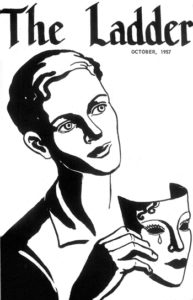
I skimmed my copy Lesbian Nuns a few months ago, and it spurred me to reflect on what I thought about Barbara Grier now, 35 years after I helped draft CCL’s protest letter to her. I also revisited my 2011 post on Grier, written shortly after she died.
In 1985, I thought Grier was a crud. How could a lesbian publisher sell personal, and often sad and painful coming out stories to a men’s sex magazine? Her goal–to reach as many lesbians as possible- was enough to override every other consideration and objection.
In 2020, my view of Grier is more nuanced. In order to become a successful publisher of lesbian literature in a homophobic world, she needed to be single-minded, relentless and ambitious to endure and prevail. She was a hard worker, tough, and totally dedicated to her ideal of lesbian visibility. “Her goal in publishing,” said Donna McBride, “was to make lesbians happy about themselves.” Books that made lesbians feel secure in their sexual identities were the best. Grier succeeded, and made the world a better place for lesbians. They could see themselves and their lives in books at last. 
Grier was also blunt, nasty, calculating, and operated with flexible ethics—think of the Forum sale and the DOB membership list theft. I wonder if she had the idea of starting a book company when she took the list. I bet she did.
As lesbians and gay men continue to integrate into ordinary life and communities, workplaces, parishes, television shows and elected offices, this quote from Grier in 1968 flashes a warning: “When we have amalgamated and homogenized and pasteurized ourselves thoroughly, we can become one of the shapeless, formless, meaningless, ‘walk alike, talk alike, think alike’ things that now live in this country—and then who will write our poetry, our novels of intensity, who will burn a futile fire, howl at the moon aimlessly?”
On the morning of August 11, 1676, a young nun named Maria was found on the floor of her cell. Her face was smeared with ink. Her hand held a sheet of paper covered with inscrutable glyphs. She told the other nuns that the Devil appeared to her in the night and tried to turn her away from her faith. To persuade Maria, the Devil took over her facilities and wrote a letter with her hand. The writing was not in Latin or any familiar language. It was a mysterious jumble of occult symbols and archaic letters. No one was able to decipher the letter by the Devil. 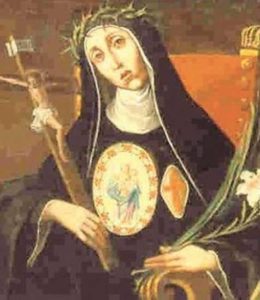
Sister Maria Crocifissa della Concezione was 15 years old when she entered the Benedictine convent in Palma di Montechiaro, Sicily. She was 31 at the time of the Devil’s visit. Maria had a history of struggling against the Devil. She would scream at him at night. In the convent’s chapel, she would shriek and lose consciousness. She was convinced that Satan was trying to turn her towards evil.
In 2017, director Daniel Abate and a research team from the Ludum science center in Catania, Sicily cracked the code. They used an algorithm found on the Deep Web. “We heard about the software,” Abate said, “which is used by intelligence services for coding breaking. We primed the software with ancient Greek, Arabic, the Runic alphabet and Latin to descramble some of the letter.” The team was eventually able to translate 15 lines, which were certainly devilish for a nun to express:
“Humans are responsible for the creation of God.”
“This system works for no one.”
“God thinks he can free mortals.”
“Perhaps now, Styx is certain.”
“God and Jesus are dead weights. 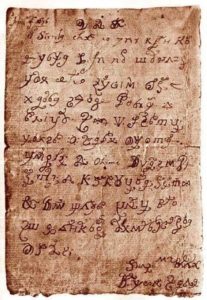 ”
”
“We speculated that Sister Maria created a new vocabulary using ancient alphabets that she may have known,” Abate said. “This is a precise alphabet, invented by the nun with great care by mixing symbols that she knew. We analyzed how the syllables and graphisms (or thoughts depicted as symbols) repeated in the letter in order to locate vowels, and we ended up with a refined decryption algorithm.” Abate thought Sister Maria had a good command of languages, which allowed her to invent the code. There is no information on what happened to her after the incident.
The letter was an elaborate hoax by Sister Maria. Why did she do it? How was she sure that she would not be found out? If she knew ancient alphabets, didn’t any of the other nuns at her convent know them as well? Abate believes the nun had schizophrenia, which made her imagine dialogues with the Devil.
Here’s my guess across 344 years: She was frustrated, pent-up, tormented by sexual desires or guilt. She had some doubts about the faith, which bothered her. Her small stage as a woman and as a nun bothered her. She was conflicted, she wanted attention, and she acted out her doubts and obsessions. The Devil was a good prop. Once she started with the screams and convulsions, she had to keep it up. She probably wanted to keep it up; the letter was a good finale. She won her fight against Satan and became a heroine in the convent.
Sister Maria most likely heard about other demonic possessions and Satanic letters in other convents. The 17th century was full of them, all featuring young nuns tempted by sex and heresy including Aix-en-Provence in 1611; Lille in 1613, Loudon in 1634 and Louviers in 1647. They are full of real and imagined seductions by priests and other nuns. I am surprised that no one has thought to do a full-blown historical and psychological study on these possessions, and their links with sex, female rebellion, and church politics.

Paul E. Lubienecki, 62, an adjunct professor at Christ the King Seminary in East Aurora, NY was arrested on February 12, 2020, on two felony cyberstalking charges. He faces up to five years in prison if convicted.
Agents from the FBI’s Buffalo, NY field office arrested Lubienecki in connection to a death threat made against 7 Eyewitness News investigative reporter Charlie Specht. Specht has won state and national awards for his investigations of the Diocese of Buffalo. In the last six months Specht and his wife had received over 50 threatening calls from an unknown individual. 
The voicemails began in August 2019, just as the 7 Eyewitness News I-Team reported on scandals at Christ the King Seminary, where multiple seminarians quit the seminary because of alleged abuse and corruption in the diocese. The messages referenced members of Specht’s family and urged Specht to stop his reporting on the diocese. “You’re still a bad Catholic and a horrible reporter,” one voicemail warned. “I hope to God I don’t see you walking around.”
On December 4, 2019, the day Specht reported on Bishop Malone’s resignation he received this message: “Oh, you must be so happy. You destroyed the Diocese of Buffalo and Bishop Malone. Oh, you must be so proud. You’re a piece of shit, you are really a piece of shit… You must be so proud of how you destroyed everything. I’m gonna destroy your career.”
On February 4, 2020, a few hours after the diocese announced the closure of Christ the King Specht gave a live report from the seminary. Moments later, a caller left a voicemail. “You must be so happy the seminary’s closing. You’re a bad person. I know where you live…I’m gonna find you. I’m gonna kill you.”
Lubienecki had nothing to say as he left the courthouse after his arraignment. “Do you have anything to say about the cyberstalking charge?” asked 7 Eyewitness News senior reporter Eileen Buckley. “Why would you make a threat to somebody, especially to kill them. Isn’t that against the teaching of the catholic faith?” questioned Buckley.
Censor Librorum Notes: No wonder the Church is a mess with a dumb-ass like that teaching ethics at a seminary.
So I turned to the Garden of Love. That so many sweet flowers bore. And I saw it was filled with graves, And tombstones where flowers should be; And priests with black gowns were walking their rounds, And binding with briars my joys and desires. William Blake (1737-1827)
“Binding with Briars—Sex and Sin in the Catholic Church,” a book by the Rev. Richard Ginder, was published in the United States by Prentice-Hall, Inc. in 1975. It was seven years after the first Dignity convention in 1968 and six years after the Stonewall Riots. In other words, very early in the period of gay and lesbian liberation in church and American society. He begins his book by identifying himself: “I am a Roman Catholic priest. My diocese is Pittsburgh. I am in good standing and celebrate the Holy Sacrifice every day.” This statement, like much about Fr. Ginder, poses a conundrum. It’s true. But it’s also true that at that time he was on “sick leave” from pastoral assignments, and mid-point in a 10-year probation negotiated by the Pittsburgh Archdiocese. 
In 1969, after an intensive investigation, police raided his apartment in the Squirrel Hill section of Pittsburgh and found photographs of teenage boys performing sex acts with Fr. Ginder and possibly other priests from the diocese. The police also found his diaries, where Ginder detailed his and other clerics homosexual activities with young men over the previous three years. Fifty-two charges were filed against him and he pleaded guilty to several. The Diocese interceded for Ginder and got him out of jail.
Fr. Ginder was among the priests identified in the now famous August 14, 2019 Pennsylvania Grand Jury Report on sexually abusive clergy. While not a pedophile, Ginder certainly approached or had sex with high school and possibly junior high school-aged boys.
“Writing this book has forced me to rethink the whole subject of morality—rather, not to rethink it but for the first time in my life to think it all the way through,” he writes in the Forward. “I have been working on this book for twenty-five years: reading, taking notes analyzing my own inner experience and comparing it to that of others. The seed was planted in 1949 when I first realized my sexual identity.” 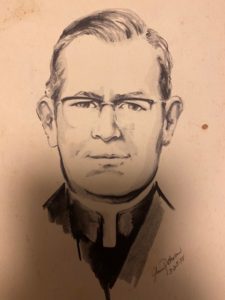
Why did Fr. Ginder write this book? He must have known going public with his opinions was a permanent career-killer.
I think three things happened. The new Gay Liberation movement inspired him to speak out. He saw people, especially young people, leaving the church in droves because the institution did not address their real-life concerns and questions. That bothered him, because he loved the church and the Catholic faith. Lastly, Ginder was a writer as well as a priest. He wrote about other controversial subjects but was banned from doing so on homosexuality. The need to express himself blew up the blockade.
The evolution of the book surprised him. “But once I started writing, I felt the book taking on a life of its own. It began to unfold and grow almost of itself as I thought through this whole matter of sexuality in its relationship to religion. I began the book a conservative and ended a liberal.”
The evolution of this blog post surprised me. I have mixed feelings about Fr. Ginder. I began by despising Ginder as a priestly predator, and ended up admiring him as a complex, prophetic, creative, and flawed man. He never acknowledged any remorse for the teenage boys he used sexually, or the emotional and psychic damage at least some of them experienced. I wonder if that is who he was as a person, or as a member of a schizophrenic clerical culture where such behavior was widespread and tacitly accepted? There’s no way of knowing.
However, how many heterosexual men ogle, fantasize and bed, if they can, 16 and 17-year-old girls? Growing up female, we learn at an early age how to deflect male sexual interest. It’s just homophobia tinged with misogyny that males become hysterical over sexual interest by other males.
Since Ginder emphasizes his evolution, I thought it would be an interesting exercise to timeline his life, and overlay his writing, arrests, and sexual abuse accusations to see when they occurred and what he was doing at the time.
1914: Charles Richard Ginder is born in Pittsburgh, Pennsylvania
June 11, 1940: He was ordained a priest of the Pittsburgh Diocese at the age of 26 by Bishop Hugh Boyle.
8/1940 – 9/1942: St. Gregory, Zelienople, PA and St. Mathias, Evans City, PA
9/1942 – 2/1946: Society of the Priests of St. Sulpice (NFI)
Ginder was a Basselin Fellow and held a master’s degree in philosophy and a Licentiate in theology from The Catholic University of America.
2/1946 – 6/1950: Saint Simon & Jude, Blairstown, PA.
1949 – Ginder discovers his homosexual identity when he was 35-nine years after his ordination. He regretted that over the next 25 years he was never permitted to express himself on the subject of homosexuality in either Our Sunday Visitor or The Priest. 
In 2007, a 69-year-old male called the Pittsburgh Diocese to report he had been molested by Ginder in the late 1940s. He said that Ginder, who was assigned to a neighboring parish, would wait outside his school to offer him rides. He did not provide specific details. After a few occasions, he no longer accepted rides from Ginder. He stated that the abuse he had suffered caused his marriage to fail; that he had feelings of guilt, and that he had attempted suicide.
Late 1940s – Early 1960s: Fr. Ginder was a widely read priest-columnist. His byline appeared in such prominent Catholic publications as Our Sunday Visitor where he wrote the controversial syndicated column “Right or Wrong.” At that time OSV was the most widely circulated Catholic periodical in the world with close to a million subscribers. He founded and edited for 11 years My Daily Visitor for shut ins. He also founded and edited The Priest, a journal for Catholic clergy which he edited for 24 years and The Catholic Choirmaster which he edited for 13 years. Ginder was also an accomplished organist and composer of sacred music. “I have written altogether one hundred twenty-four pamphlets with a total sale of twenty-six million copies. I have spoken and my musical compositions have been performed on all four of the major radio networks and on CBS-TV.” 
6/1950 – 12/1953: St. George, Pittsburgh, PA (South Side)
12/1953 – 6/1959: St. Joseph, Pittsburgh, PA (North Side)
12/1954 – 7/1962: Censor Librorum for the Diocese of Pittsburgh
A male residing in Seattle, WA contacted the Pittsburgh Diocese on a number of occasions. He never provided details of his abuse but threatened to sue the Diocese. The male was advised in 1999 that the records pertaining to Father Charles R. Ginder were destroyed as Ginder had died in 1984. The male subsequently sent a letter wherein he stated that he was taken to New York, NY and Philadelphia, PA by Ginder. He estimated the trips occurred between 1958 and 1961. He said details would be provided in a book he planned to write. The male also advised that he was abused by another priest in Pittsburgh who now lived in Florida. He refused to name the other priest, however, in order to maintain “the element of surprise.”
Fr. Ginder described himself as an open-minded conservative. His article on “Leftism in the Church” appeared in the March 27, 1960 edition of Our Sunday Visitor: “Right now in America, relativism is what might be called the ‘established’ system of thought. It is supported by the moneyed classes, the secular universities, even—insofar as that is possible—by the Government: which means that it has lavish rewards to confer on its own disciples…Confronted with such a situation, we Catholics can either convert them or join them. But if we join them, we will no longer be Catholic. We have to convert them, for by God’s own definition we are “the salt of the earth.”
6/1959 – 2/1961: St. Mary, New Castle, PA
In 2013, an adult male reported that he was befriended by Ginder following the death of his brother in 1960. He stated that they often made trips from New Castle to Pittsburgh and had dinner together. The male recalled that on one occasion; he fell asleep in the front seat of the car following dinner with Ginder. He woke to find Ginder putting his hand up his pant leg, touching his thigh. When he asked what he was doing, Ginder explained that he was checking to see if the boy was cold. After this incident, he did not accompany Ginder anywhere else.
12/1961 – 8/1962: School Sisters of St. Francis, Bellevue, PA
7/1962 – 7/1963: Health related leave of absence
8/1963 – 5/1964: Our Lady of Mercy Academy (NFI)
5/1964 – 6/1964: St. Januarius, Pittsburgh, PA
5/1964 – 6/1964: St. John the Baptist, Pittsburgh, PA
6/1964 – 1/1967: Sick Leave
1/1967 -? : St. John the Baptist, Baden, PA
In 2002, a 50-year-old male living in New Jersey reported that he had been abused by Ginder when he was between the ages of 15 and 17. He stated that he and a boy from Denmark would gather at the residence of the Bishop on many occasions. He stated that they would drink alcohol with Ginder and ‘sexual activity would occur there.’ According to the male, the sexual activity occurred with Ginder and the Bishop was aware of it. The male further stated that he lived with Ginder on Murray Avenue for a short time. He stated that the relationship with Ginder and others was ‘out of control.” He described Ginder as a ‘physically abusive monster.’”
See my recent post on Pittsburgh’s Bishop Wright: “Lip Service: John Cardinal Wright Gives Himself a Celibacy Dispensation.” Pittsburgh must have been a congenial posting if you were a sexually active homosexual priest in the 1960s.
1969: Fr. Ginder’s apartment is raided by police. They discover photos of Ginder and others in homosexual sex acts. The Diocese negotiates Ginder’s release from jail and he is put on ten years’ probation.
1969: Bishop John Wright is promoted or “kicked upstairs” to a Vatican appointment.
1970-1984: Sick Leave. Ginder lives in church facilities under psychiatric care. For a time he lived in a Vincentian facility in McCandless, PA.
1975: Ginder’s semi-autobiographic book, “Binding with Briars—Sex and Sin in the Catholic Church,” is published.
The book argued against Catholic positions on birth control, divorce, premarital sex and homosexuality. Ginder also clearly came out against abortion, pedophilia, and legalizing homosexual relationships— “…the analogy with matrimony is all wrong. For one thing, it reeks of sacrilege, blasphemy, and bad taste.”
In the book Ginder addressed the nastiness and hostility of some religious people to homosexuals: “The latent gay is sexually attracted by others of the same sex, but he refuses to admit it to himself and in fighting the tendency he often overreacts by lashing out at overt gays and harassing them as best he can.” Ginder quoted Winston Leyland, a “priestly dropout” and editor of the Bay area publication, Gay Sunshine, who estimated that 40% of Catholic clergy was gay.
Ginder did touch briefly on Dignity, a newly formed organization for gay and lesbian Catholics. He was mildly supportive. I think Ginder was less enthusiastic than he might have been, because he believed so strongly that gay people needed to stay in the Church, not go off or segregate themselves in other groups. In Chapter 13, “The Other Love,” he writes: “Now surely this book, especially this present chapter, has given the gay arguments and principles enough to form his conscience on gay sex and still receive the sacraments—so, Mr. and Ms. Gay, spread the word: Gays can be just as good Catholics as the rest and still have their sex. Don’t let them quit the Church, for their own good and ours—because, you see, we need their help in forming a consensus. We need them on the team.”
Fr. Ginder also offers a solution to gay and lesbian Catholics trying to keep the faith: “Keep trying to develop a personal religion, an immediate relationship with our Lord,” he says. “Use the Church for the Holy Sacrifice, the sacraments, inspiration, and moral instruction; but keep your life centered on Christ. What matters is His, not the churchmen’s opinion of you. Keep deepening your fundamental option with an intense and unshakeable loyalty to our Lord.”
As a Catholic lesbian who continues to identity herself as such 40 years after coming out, Fr. Ginder’s advice on how to remain in the church is true: follow your conscience and keep your eyes on Christ.
In 1975, Ginder was asked if he was sorry about his homosexual activities. I don’t approve of it but sometimes you’re weak,” he said.
1976: One year after the publication of “Binding with Briars,” Bishop Vincent M. Leonard, Wright’s successor, stripped Ginder of his priestly facilities.
1978: Ginder was arrested in the Southside of Pittsburgh and convicted of sodomizing two 16-year-old boys and sentenced up to four years in prison. There was also a report that he attempted suicide.
1980: Fr. Ginder lived at the One Hundred Acres Trappist Monastery in New Hampshire, not far from Boston, MA.
In 2011, an adult male reported sexual abuse through the Diocese of Manchester in New Hampshire. He stated that in 1980, when he was approximately 15 or 16 years old, he attended an overnight retreat at Hundred Acres in New Boston. Another man, possibly a priest, attempted to assault him in his room. When he screamed loudly, Ginder came into the room. Ginder then offered to drive him home. During the car ride, Ginder pulled over by a river. He then fondled the young man on top of his clothes. The young man got out of the vehicle before it went any further and took a bus home.
June 7, 1984: Killed in a car accident. The Pittsburgh Post-Gazette published his obituary on Wednesday, June 13, 1984. The headline reads: “Priest touched by scandal is quietly buried in city.” 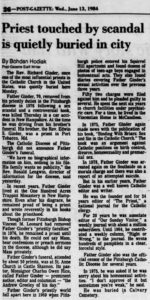
“The Rev. Richard Ginder, once one of the most influential priests in the Catholic Church in the United States, was quietly buried here Monday. Father Ginder, 70, removed from his priestly duties in the Pittsburgh diocese in 1976 following a sex scandal and a controversial book, was killed Thursday in a car accident in New Hampshire. At the time he was driving from his brother’s funeral. His brother, the Rev. Edwin S. Ginder, was a priest in Fort Tobacco, MD. Father Ginder’s funeral, was at St. Anne Church in Castle Shannon, PA. Its pastor, Monsignor Charles Owen Rice, called Father Ginder – prominent editor, author and columnist – “the Andrew Greeley of his day.”
In the Forward to the book he acknowledges, “My opinions may have to travel underground in the Church until popular sentiment is ready to accept them.” That shift of opinion occurred 40 years after the publishing of the book. It was made possible by the loss of respect and moral authority of the Church for how it handled clerical sexual abuse. Ginder was a part of that chain of abuse, shuffled around from parish to parish, his behavior tolerated and covered up with “sick leave” stays in various institutions and places. Once the church ceased to protect him, the civil authorities were able to reach him for punishment.
Fr. Ginder did not acknowledge himself as a gay man in his writing, although he may have done so with other gay clergy. What he did do in “Binding with Briars” was to assert that gay sex—sodomy– is normal to gay people and stated that the Church was out of touch with the sexual morality and lives of many of the faithful, gay and straight. This stance was leading to the marginalization of the Church and the loss of believers. This loss was very painful to Ginder, and he wanted to stop the hemorrhaging.
“For several years I was the official censor of books for the Diocese of Pittsburgh,” he wrote. “It is with prayer and no little trepidation that I submit my analysis, hoping that it may bring some degree of comfort, however slight, to the reader. All my life has been a preparation for the writing of this book.”
I wish I had known of Fr. Ginder’s book many years ago. It would have been a great help to me in negotiating the agonies of faith and desire. It would have been a great comfort, and is still a comfort today. Thank you, Fr. Ginder.

The National Prayer Breakfast is a Washington, DC tradition that stretches back to 1953, when president Dwight Eisenhower established it at the suggestion of evangelist Billy Graham. It is a bi-partisan event with political, business and civic leaders coming together to pray. Many members of Congress normally attend.
Yesterday’s breakfast had a different vibe. President Trump used the podium to attack supporters of his impeachment drive. “As everybody knows, my family, our great country and your president have been put through a terrible ordeal by some very dishonest and corrupt people,” Trump said. He scolded his opponents by saying impeachment supporters “know what they are doing is wrong, but they put themselves far ahead of our great country.” He added, “I don’t like people who use their faith as justification for doing what they know is wrong.” He went on, “Nor do I like people who say, ‘ I pray for you’ when you know that is not so.” The last jab was directed at House Speaker Nancy Pelosi, who has previously said she prays for him. 
Pelosi responded in a news conference after the event. She told reporters it was “completely inappropriate” for Trump to criticize people for looking to their faith as a basis for their decisions–“especially at a prayer breakfast.” “I pray hard for him because he’s so off the track of our constitution, our values, our country,” she said. “He really needs our prayers.”
I’m not sure all the prayers in the world will help our dysfunctional Congress, and the nasty, pathological liar we have for a president. President Trump is Roy Cohn resurrected.


































